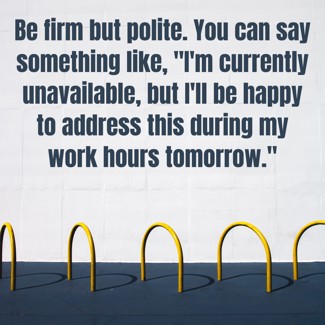Stop WFH Burnout: Set Boundaries, Reclaim Your Life
Working from home (WFH) offers flexibility, but it also blurs the lines between professional and personal life. This constant state of being “on” can quickly lead to WFH burnout, a state of emotional, physical, and mental exhaustion caused by prolonged or excessive work-related stress. This article explores why setting boundaries is crucial for preventing burnout in the digital workplace. We’ll cover practical strategies to create a healthier work-life balance, reclaim your time, and boost your overall well-being, without sacrificing your professional productivity.
Understanding WFH Burnout: More Than Just Tiredness
WFH burnout isn’t just about feeling a bit tired at the end of the day. It’s a deeper state of exhaustion that impacts multiple aspects of your life. While the initial appeal of working from home – no commute, flexible hours – is strong, the reality can be very different.
The always-on culture of the digital workplace, coupled with the difficulty in separating work from home life when they occupy the same space, creates a perfect storm for burnout. A study by the American Psychological Association found that remote workers were more likely to report feeling “constantly connected” to work and experiencing higher levels of stress.
The Warning Signs
Recognizing the symptoms of WFH burnout is the first step in addressing it.
- Emotional Exhaustion: Feeling drained, emotionally depleted, and unable to cope.
- Physical Fatigue: Persistent tiredness, even after getting adequate sleep.
- Reduced Professional Efficacy: Feeling less capable, less productive, and experiencing a decline in job satisfaction.
- Increased Cynicism: Developing a negative or detached attitude towards work.
- Difficulty Concentrating: Finding it hard to focus on tasks and stay engaged.
- Sleep Disturbances: Experiencing insomnia or other sleep-related problems.
- Irritability and Mood Swings: Becoming easily frustrated or experiencing sudden changes in mood.
- Neglecting Personal Needs: Skipping meals, lack of exercise, and a reduction in self-care activities.

Contributing Factors
Several factors contribute to the increased risk of burnout for remote workers.
- Lack of Clear Boundaries: The absence of a physical separation between work and home makes it difficult to switch off.
- Increased Workload: Some remote workers report feeling pressure to work longer hours to prove their productivity.
- Social Isolation: Reduced interaction with colleagues can lead to feelings of loneliness and disconnection.
- Technological Overload: Constant exposure to emails, messages, and notifications can be overwhelming.
- Ergonomic Concerns: An inadaquate workspace at home can cause physical discomfort and stress.
- Difficulty Unplugging: The expectation of constant availability makes it hard to disconnect from work.
Creating Physical Boundaries: Design Your Workspace
Establishing a dedicated workspace is essential for creating a physical separation between work and home life, even if you don’t have a separate office.
Defining Your Work Zone
- Choose a Specific Area: Designate a particular area in your home solely for work. This could be a spare room, a corner of a room, or even a specific chair at the kitchen table. The key is consistency.
- Optimize for Ergonomics: Ensure your workspace is set up correctly to minimize physical strain. Invest in a good chair, proper lighting, and consider a standing desk converter.
- Minimize Distractions: Keep your workspace free from clutter and distractions. Let your family or housemates know that when you’re in your “work zone,” you’re not to be disturbed unless it’s important.
- Create a “Commute” Ritual: Even though you’re not physically commuting, create a routine that signals the start and end of your workday. This could be a short walk, a cup of coffee, or changing clothes. This psychological separation is surprisingly effective.
- Clearly define working and non working areas. Separate work materials and equipment, from personal items.
Setting Visual Cues
Visual cues can also help reinforce the boundary between work and home.
- Use a “Do Not Disturb” Sign: A simple sign can signal to others when you’re in work mode.
- Change Your Surroundings: When you finish work, make a small change to your workspace. This could be closing your laptop, putting away work materials, or simply turning off the desk lamp.
- Use Different Devices: If possible, use separate devices for work and personal use. This helps create a mental separation.
Establishing Temporal Boundaries: Time Management is Key
Setting clear time boundaries is equally important for preventing WFH burnout. The goal is to create a structured workday that allows for focused work and sufficient downtime.
Defining Your Work Hours
- Set a Schedule: Establish a consistent work schedule and stick to it as much as possible. This provides structure and helps you manage your time effectively.
- Communicate Your Availability: Let your colleagues and clients know your working hours and when you’ll be available.
- Take Regular Breaks: Schedule short breaks throughout the day to rest and recharge. Step away from your computer, stretch, or do something completely unrelated to work.
- Avoid working weekends unless absoultely necessary. Give yourself time to disconnect.
- Use Time-Blocking Techniques: Allocate specific blocks of time for different tasks. This can help you stay focused and avoid multitasking, which is often less productive.

Managing Notifications
Constant notifications can be a major source of distraction and stress.
- Turn Off Non-Essential Notifications: Disable notifications for emails, messages, and social media during focused work periods.
- Set Specific Times to Check Emails: Avoid constantly checking your inbox. Designate specific times throughout the day to respond to emails.
- Use “Do Not Disturb” Mode: Utilize the “Do Not Disturb” feature on your devices to silence notifications during breaks and after work hours.
Communicating Boundaries: Assertiveness and Expectations
Effectively communicating your boundaries to colleagues, clients, and family members is crucial for maintaining them.
Setting Expectations with Colleagues and Clients
- Be Clear and Direct: Communicate your working hours and availability clearly and assertively.
- Respond to Emails During Work Hours: Avoid responding to emails and messages outside of your designated work hours, unless it’s a genuine emergency.
- Set Boundaries for Meetings: Schedule meetings during your work hours and be mindful of meeting length. Encourage concise and productive meetings.
- Establish preferred methhods of contact. Limit unscheduled video calls or phone calls.
Communicating with Family and Housemates
- Have Open Conversations: Discuss your work schedule and boundaries with your family or housemates. Explain the importance of uninterrupted work time.
- Set Clear Expectations: Let them know when you’re available and when you need to focus on work.
- Create Shared Schedules: If possible, create a shared schedule that outlines everyone’s work and personal commitments. This can help minimize conflicts and interruptions.
Concept for a third info graphic: A circle divided, representing a 24h period. Sections highlighted to show dedicated working hours, breaks, and personal time.
alt text: Circle chart show work-life balance schedule.
Digital Detox and Self-Care: Prioritizing Well-being
Taking time to disconnect from technology and prioritize self-care is essential for combating WFH burnout.
Digital Detox Strategies
- Schedule Tech-Free Time: Designate specific times each day or week to completely disconnect from technology. This could be during meals, evenings, or weekends.
- Create Tech-Free Zones: Designate certain areas in your home, such as the bedroom, as tech-free zones.
- Use App Blockers: Utilize apps that block access to distracting websites and apps during specific times.
- Engage in Offline Activities: Find activities that you enjoy and that don’t involve technology, such as reading, exercising, spending time in nature, or pursuing hobbies.
Prioritizing Self-Care
- Get Enough Sleep: Aim for 7-8 hours of quality sleep per night.
- Eat Nutritious Meals: Maintain a healthy diet and avoid skipping meals.
- Exercise Regularly: Incorporate physical activity into your daily routine.
- Practice Mindfulness and Relaxation: Engage in activities that help you relax and manage stress, such as meditation, yoga, or deep breathing exercises.
- Connect with Loved Ones: Spend time with family and friends, even if it’s virtually.
- Seek social interactions. Keep in touch with friends and family.
Quick Takeaways
- WFH burnout is a serious condition caused by the blurring of work and personal life.
- Setting clear boundaries – physical, temporal, and communicative – is crucial for preventing WFH Burnout.
- Creating a dedicated workspace, managing your time, and communicating expectations are key strategies.
- Digital detox and self-care are essential for maintaining well-being and preventing burnout.
- Recognizing the early warning signs allows for timely intervention.
- Small, consistant changes can create a healthier work-life balance.
- Prioritizing your health is not selfish, it is essential.
Conclusion
WFH burnout is a growing concern in today’s digital workplace, but it’s not inevitable. By implementing the strategies outlined in this article – setting clear boundaries, managing your time effectively, and prioritizing self-care – you can create a healthier and more sustainable work-from-home experience. Remember that your well-being is paramount, and taking proactive steps to prevent burnout will benefit both your personal and professional life. Making small changes can lead to significant improvements in your overall health and happiness. You deserve to have a work-life balance, even when home and the workplace are in the same building.
Frequently Asked Questions
- What if my job requires me to be “always on”? Even in demanding jobs, it’s possible to set some boundaries. Discuss expectations with your manager, prioritize tasks, and find ways to create small pockets of downtime.
- How can I deal with feelings of guilt when I’m not working?Recognize that taking breaks and disconnecting is essential for your productivity and well-being. Remind yourself that you’re not neglecting your responsibilities; you’re recharging so you can perform at your best.
- How do I politely decline work requests outside of my work hours?

- What if I’m feeling isolated working from home? Schedule regular virtual coffee breaks or chats with colleagues, join online communities related to your profession or interests, and make an effort to connect with friends and family outside of work.
- My home life is chaotic, How can I set any kind of boundary?
Communicate openly about your needs. Find even the smallest ammount of space and time that can be work only. Seek compromises with family members or housemates, and focus on controlling what you can.



